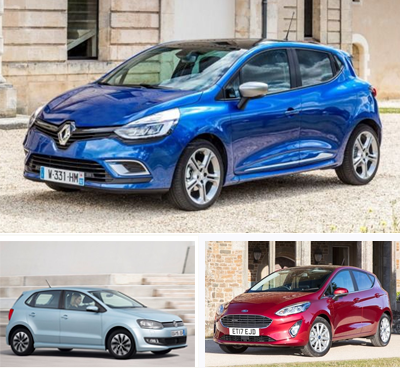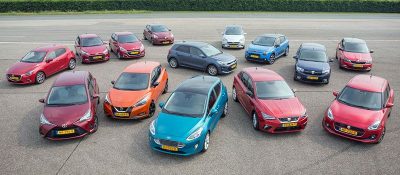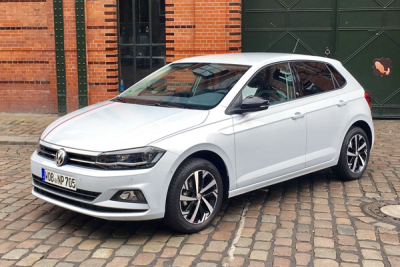 The subcompact car segment in Europe increased by 2% to nearly 2,79 million sales in 2017. Europe’s largest segment by volume still accounts for 18% of the total market, down from 18,1% in 2016. The segment declined by 2% in Q4 as two of the top-3 players were in double digit declines due to model changeovers. This allowed the Renault Clio to extend its pole position to a 50.000 sales lead over the #2. The former traditional best seller Ford Fiesta remains stuck in third place behind the Volkswagen Polo, which was in a lowly 6th place in the fourth quarter even behind the Citroën C3 and Toyota Yaris. The former of these is the big winner in the top-10 thanks to its new generation, topping 200.000 sales for the first time since 2010. Its stablemate Peugeot 208 moved up one spot in the ranking after a strong finish of the year with a 2nd place in Q4, helping it to leapfrog the Opel/Vauxhall Corsa which takes a big hit in the second quarter after PSA took over the Opel/Vauxhall brand and decided to emphasize profit over volume, reducing discounts and sales to daily rental companies. Corsa sales declined 23% in Q4.
The subcompact car segment in Europe increased by 2% to nearly 2,79 million sales in 2017. Europe’s largest segment by volume still accounts for 18% of the total market, down from 18,1% in 2016. The segment declined by 2% in Q4 as two of the top-3 players were in double digit declines due to model changeovers. This allowed the Renault Clio to extend its pole position to a 50.000 sales lead over the #2. The former traditional best seller Ford Fiesta remains stuck in third place behind the Volkswagen Polo, which was in a lowly 6th place in the fourth quarter even behind the Citroën C3 and Toyota Yaris. The former of these is the big winner in the top-10 thanks to its new generation, topping 200.000 sales for the first time since 2010. Its stablemate Peugeot 208 moved up one spot in the ranking after a strong finish of the year with a 2nd place in Q4, helping it to leapfrog the Opel/Vauxhall Corsa which takes a big hit in the second quarter after PSA took over the Opel/Vauxhall brand and decided to emphasize profit over volume, reducing discounts and sales to daily rental companies. Corsa sales declined 23% in Q4.
Note: clicking on the model name opens the sales data page for that model; clicking year in the legend turns the display for that year on/off
 Behind the top-7, the Dacia Sandero extends its winning streak to 7 consecutive years of growth to set another annual record and finishes in a record 8th place with almost 200.000 sales, ahead of two VW Group models Skoda Fabia and Seat Ibiza. The latter is disappointingly down by 2% despite an all-new generation. Perhaps the loss of its station wagon and 3-door versions are hurting the Spanish subcompact. The Hyundai i20 sets a new volume record, topping 100.000 sales for the first time ever. Its predecessor Getz last sold six figures in 2005. The new generation Nissan Micra gives the nameplate a big boost with sales up 44% to the highest volume since 2006 but still far behind the figures it sold in the ’90s and early 2000s. The Kia Rio was also renewed but as the outgoing model finished on a strong note with 4 consecutive years of growth, the new model is unable to give it such a boost as the Micra did. Nonetheless the Rio also sets a new volume record for the nameplate. The Ford Ka+ enters the top-10 ahead of the antediluvian Fiat Punto, down to its lowest sales ever after 8 straight years of decline, and less than 10% of the volume it sold in the late ’90s and early 2000s. The new generation Suzuki Swift showed a 25% increase in Q4 to outsell the latter two models, but is still down by double digits for the year, while its stablemate Baleno goes the exact opposite: down 17% in Q4 but still up for the year.
Behind the top-7, the Dacia Sandero extends its winning streak to 7 consecutive years of growth to set another annual record and finishes in a record 8th place with almost 200.000 sales, ahead of two VW Group models Skoda Fabia and Seat Ibiza. The latter is disappointingly down by 2% despite an all-new generation. Perhaps the loss of its station wagon and 3-door versions are hurting the Spanish subcompact. The Hyundai i20 sets a new volume record, topping 100.000 sales for the first time ever. Its predecessor Getz last sold six figures in 2005. The new generation Nissan Micra gives the nameplate a big boost with sales up 44% to the highest volume since 2006 but still far behind the figures it sold in the ’90s and early 2000s. The Kia Rio was also renewed but as the outgoing model finished on a strong note with 4 consecutive years of growth, the new model is unable to give it such a boost as the Micra did. Nonetheless the Rio also sets a new volume record for the nameplate. The Ford Ka+ enters the top-10 ahead of the antediluvian Fiat Punto, down to its lowest sales ever after 8 straight years of decline, and less than 10% of the volume it sold in the late ’90s and early 2000s. The new generation Suzuki Swift showed a 25% increase in Q4 to outsell the latter two models, but is still down by double digits for the year, while its stablemate Baleno goes the exact opposite: down 17% in Q4 but still up for the year.  The Renault Zoe electric car has connected with the mainstream part of the ranking at #20.
The Renault Zoe electric car has connected with the mainstream part of the ranking at #20.
2018 sales in the subcompact segment are expected to grow slightly as the all-new versions of the Fiesta and Polo will fuel growth, and the C3, Ibiza, Micra and Rio are also still fresh, but a new Clio not available until 2019. The new Opel/Vauxhall Corsa was supposed to arrive in 2018, but the PSA takeover has delayed that project to 2019. The Fabia, i20 and Ka+ will be facelifted and Fiat may finally replace the Punto with a model based on the Brazilian Argo.
Also check out the subcompact segment in the US, which is in fast decline with double digit losses for the entire top-4 and only one model growing: the rebadged Mazda2 sedan sold as the Toyota Yaris iA.
| Subcompact segment | 2017 | 2016 | Change | |
| 1 | Renault Clio | 321.472 | 310.944 | 3% |
| 2 | Volkswagen Polo | 271.369 | 307.462 | -12% |
| 3 | Ford Fiesta | 255.602 | 298.999 | -15% |
| 4 | Peugeot 208 | 242.589 | 247.379 | -2% |
| 5 | Opel/Vauxhall Corsa | 231.434 | 262.939 | -12% |
| 6 | Citroën C3 | 205.272 | 133.566 | 54% |
| 7 | Toyota Yaris | 198.578 | 192.005 | 3% |
| 8 | Dacia Sandero | 194.996 | 167.766 | 16% |
| 9 | Skoda Fabia | 177.116 | 175.264 | 1% |
| 10 | Seat Ibiza | 117.780 | 120.465 | -2% |
| 11 | Hyundai i20 | 100.571 | 98.956 | 2% |
| 12 | Nissan Micra | 86.489 | 60.212 | 44% |
| 13 | Kia Rio | 70.309 | 67.622 | 4% |
| 14 | Dacia Logan | 54.029 | 51.055 | 6% |
| 15 | Ford Ka+ | 51.277 | 10.588 | 384% |
| 16 | Fiat Punto | 49.688 | 62.654 | -21% |
| 17 | Suzuki Swift | 38.576 | 44.378 | -13% |
| 18 | Honda Jazz | 34.898 | 37.005 | -6% |
| 19 | Mazda2 | 31.703 | 36.463 | -13% |
| 20 | Renault Zoe | 30.134 | 21.240 | 42% |
| 21 | Suzuki Baleno | 18.518 | 14.523 | 28% |
| 22 | MG3 | 3.093 | 3.243 | -5% |
| 23 | Lada Granta | 998 | 616 | 62% |
| 24 | Lada Kalina | 653 | 1.048 | -38% |
| 25 | Chevrolet Aveo | 3 | 37 | -92% |
| 26 | Peugeot 207 | 2 | 21 | -90% |
| 27 | Mitsubishi Colt | 1 | 1 | 0% |
| Segment total | 2.787.150 | 2.726.451 | 2% |
Click on any model to see its annual sales from 1997-2016 and monthly sales from 2012 to 2016, or use the dropdown menu in the top right of this site.
Car sales statistics are from the following countries: Austria, Belgium, Cyprus, Czech Republic, Denmark, Estonia, Finland, France, Germany, Great Britain, Greece, Hungary, Iceland, Ireland, Italy, Latvia, Lithuania, Luxembourg, Netherlands, Norway, Poland, Portugal, Romania, Slovakia, Slovenia, Spain, Sweden, Switzerland.
Sources: Manufacturers, ANDC, JATO Dynamics.


